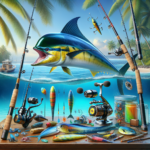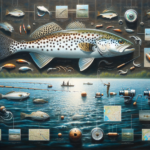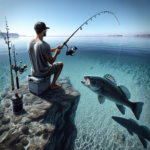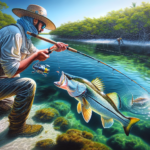Fishing Tips on How to Catch Mahi-Mahi (Dolphinfish)

Introduction
Mahi-Mahi, also known as dolphinfish, is a vibrant and highly sought-after species in the world of sport and recreational fishing. Known for their striking colors, acrobatic fights, and delicious taste, Mahi-Mahi are a favorite among anglers. This article will provide a comprehensive guide on how to catch Mahi-Mahi, covering everything from their physical characteristics and behavior to the best fishing techniques, gear recommendations, and common mistakes to avoid.
Fish Species Overview
Description
Mahi-Mahi are easily recognizable due to their bright, iridescent colors. They typically exhibit a mix of blue, green, and yellow hues, with males (bulls) having a prominent forehead. They can grow up to 4-5 feet in length and weigh between 15-30 pounds, although larger specimens are not uncommon.
Habitat
Mahi-Mahi are predominantly found in warm, tropical, and subtropical waters. They thrive in saltwater environments and are commonly found in the Atlantic, Indian, and Pacific Oceans. They prefer open waters but are often found near floating debris, seaweed patches, and other structures that provide cover and attract baitfish.
Behavior
Mahi-Mahi are known for their aggressive feeding habits. They primarily feed on smaller fish, squid, and crustaceans. Their spawning season occurs year-round in warm waters, with peaks during the spring and early summer. Mahi-Mahi are most active during the early morning and late afternoon, making these times ideal for fishing.
Challenges
One of the main challenges anglers face when targeting Mahi-Mahi is their speed and agility. They are known for their powerful runs and acrobatic jumps, which can make landing them a challenge. Additionally, their preference for open waters means that finding them can sometimes be difficult without the right knowledge and equipment.
Best Time to Catch Mahi-Mahi
Seasonal Considerations
The best time to catch Mahi-Mahi is during the warmer months, typically from late spring to early fall. In tropical regions, they can be caught year-round, but their numbers peak during these months.
Time of Day
Mahi-Mahi are most active during the early morning and late afternoon. These times are ideal for fishing as the fish are more likely to be feeding and less wary of potential threats.
Weather Conditions
Calm, clear days with minimal wind are ideal for Mahi-Mahi fishing. These conditions make it easier to spot the fish and present your bait effectively. However, slightly overcast days can also be productive as they reduce glare on the water, making it easier to see the fish.
Top Fishing Techniques for Mahi-Mahi
Technique 1: Trolling
Trolling is one of the most effective techniques for catching Mahi-Mahi. This involves dragging lures or bait behind a moving boat. The movement mimics the action of fleeing prey, attracting the attention of Mahi-Mahi. Use brightly colored lures or rigged ballyhoo to increase your chances of success.
Technique 2: Casting
Casting is another popular method, especially when you spot a school of Mahi-Mahi near the surface. Use a spinning or baitcasting reel with a fast-action rod to cast lures or live bait towards the fish. Retrieve the lure quickly to mimic the movement of a fleeing baitfish.
Technique 3: Chumming
Chumming involves dispersing small pieces of bait into the water to attract Mahi-Mahi to your location. This technique is particularly effective when fishing near floating debris or seaweed patches. Once the fish are attracted to the chum, you can use live bait or lures to catch them.
Pro Tips
- Use a variety of lures and baits to see what the fish are biting on that day.
- Keep an eye out for birds diving into the water, as this often indicates the presence of baitfish and, consequently, Mahi-Mahi.
- Be prepared for a fight; Mahi-Mahi are known for their acrobatic jumps and powerful runs.
Recommended Gear for Catching Mahi-Mahi
Fishing Rod and Reel
A medium to heavy-action rod paired with a high-quality spinning or conventional reel is ideal for Mahi-Mahi fishing. Look for a rod that is 6-7 feet in length to provide the necessary leverage and control.
Fishing Line
Use a braided line with a strength of 30-50 pounds. Braided lines offer excellent strength and sensitivity, allowing you to feel even the slightest bites. Attach a fluorocarbon leader to the end of your line to reduce visibility and increase your chances of success.
Hooks and Baits
For hooks, use sizes 4/0 to 7/0, depending on the size of the bait and the fish you are targeting. Live baits such as ballyhoo, pilchards, and squid are highly effective. Artificial lures like trolling skirts, poppers, and jigs also work well.
Additional Gear
- Bobbers: Useful for keeping your bait at the desired depth.
- Sinkers: Necessary for keeping your bait near the bottom when fishing in deeper waters.
- Leaders: Use fluorocarbon leaders to reduce visibility and prevent the fish from biting through the line.
Best Locations to Find Mahi-Mahi
General Locations
Mahi-Mahi are typically found in open ocean waters, often near floating debris, seaweed patches, and other structures that provide cover and attract baitfish. They are also commonly found around offshore oil rigs and FADs (Fish Aggregating Devices).
Specific Regions
Some of the best regions for Mahi-Mahi fishing include the Gulf of Mexico, the Caribbean Sea, the waters off the coast of Florida, and the Pacific Ocean near Hawaii. These areas are known for their warm waters and abundant Mahi-Mahi populations.
Common Mistakes to Avoid
Mistake 1: Using the Wrong Gear
Using gear that is too light or too heavy can hinder your chances of success. Make sure to use a medium to heavy-action rod and a high-quality reel with a strong braided line.
Mistake 2: Ignoring the Weather
Fishing in poor weather conditions can make it difficult to spot and catch Mahi-Mahi. Aim to fish on calm, clear days with minimal wind for the best results.
Mistake 3: Not Varying Your Techniques
Sticking to one technique can limit your success. Be prepared to switch between trolling, casting, and chumming to see what works best on any given day.
Catch and Release Tips
Importance of Conservation
Practicing catch and release is crucial for maintaining healthy Mahi-Mahi populations and ensuring the sustainability of the species. Always follow local regulations and size limits to contribute to conservation efforts.
Proper Handling Techniques
- Use wet hands or a wet cloth to handle the fish to avoid removing their protective slime coating.
- Minimize the time the fish spends out of the water to reduce stress.
- Use barbless hooks or crimp the barbs to make hook removal easier and less damaging.
Legal Considerations
Always check local regulations regarding size limits, bag limits, and protected areas before fishing for Mahi-Mahi. Ensure you have the necessary fishing licenses and permits to avoid legal issues.
Frequently Asked Questions (FAQs)
What is the best bait for catching Mahi-Mahi?
The best baits for catching Mahi-Mahi include live baits such as ballyhoo, pilchards, and squid. Artificial lures like trolling skirts, poppers, and jigs are also effective. The choice of bait can depend on the season, water conditions, and local preferences.
Where is the best place to fish for Mahi-Mahi?
Mahi-Mahi are commonly found in open ocean waters near floating debris, seaweed patches, and other structures that attract baitfish. Popular fishing spots include the Gulf of Mexico, the Caribbean Sea, the waters off the coast of Florida, and the Pacific Ocean near Hawaii.
What time of day is best for catching Mahi-Mahi?
The best time of day to catch Mahi-Mahi is during the early morning and late afternoon when they are most active and feeding. These times offer the highest chances of success.
What type of fishing line should I use for Mahi-Mahi?
A braided line with a strength of 30-50 pounds is recommended for Mahi-Mahi fishing. Braided lines offer excellent strength and sensitivity, allowing you to feel even the slightest bites. Attach a fluorocarbon leader to reduce visibility and increase your chances of success.
Do I need a special fishing license to catch Mahi-Mahi?
Yes, you typically need a fishing license to catch Mahi-Mahi. Licensing requirements vary by location, so it’s important to check local regulations regarding size limits, bag limits, and any special permits needed before you go fishing.
What is the best technique for catching Mahi-Mahi?
Trolling is one of the most effective techniques for catching Mahi-Mahi. This involves dragging lures or bait behind a moving boat to mimic the action of fleeing prey. Casting and chumming are also effective methods, depending on the situation.
Are there any specific weather conditions that improve the chances of catching Mahi-Mahi?
Calm, clear days with minimal wind are ideal for Mahi-Mahi fishing. These conditions make it easier to spot the fish and present your bait effectively. Slightly overcast days can also be productive as they reduce glare on the water.
Can I catch Mahi-Mahi from the shore, or do I need a boat?
Mahi-Mahi are typically found in open ocean waters, so fishing from a boat is generally more effective. However, in some regions, they can be caught from shore if there are deep drop-offs or structures that attract them close to land.
How can I improve my chances of landing a big Mahi-Mahi?
To improve your chances of landing a big Mahi-Mahi, use larger baits or lures, fish during peak feeding times (early morning and late afternoon), and target areas with abundant baitfish. Using high-quality gear and being prepared for a fight will also increase your chances of success.
What should I do if I plan to release Mahi-Mahi after catching them?
If you plan to release Mahi-Mahi, practice ethical catch and release techniques. Use wet hands or a wet cloth to handle the fish, minimize the time it spends out of the water, and use barbless hooks or crimp the barbs for easier hook removal. Always follow local regulations regarding size limits and protected areas.
Conclusion
Catching Mahi-Mahi can be an exhilarating and rewarding experience for anglers of all skill levels. By understanding their behavior, using the right techniques and gear, and practicing ethical fishing practices, you can increase your chances of success. Remember to always follow local regulations and contribute to conservation efforts to ensure the sustainability of this incredible species. So, grab your gear, head out to the open waters, and put these tips into practice for an unforgettable fishing adventure.




